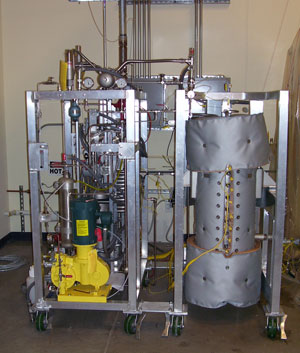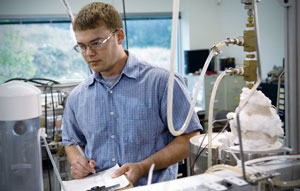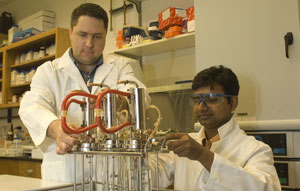Discovering New Uses for Glycerin




September 4, 2007
BY Jessica Ebert
Much research by several companies and academic groups centers on breaking into the propylene glycol (PG) market with a biobased form of the compound produced from glycerin. At this time, PG is almost exclusively made from propylene oxide, a derivative of propylene, which is a petrochemical feedstock. The yearly demand for PG exceeds 2 billion pounds and growing. The compound is used in everything from pet food and paints to polyester resins, lubricants, antifreeze and cosmetics.
In early May, Cargill Inc. and Ashland Inc. announced a joint venture to develop and produce a range of biobased chemicals. The first product to be marketed will be renewable PG, which the two companies expect to commercialize by mid-2008 and produce at a 65,000-metric-ton-per-year plant to be built in Europe, although the exact plant location has yet to be determined.
"Cargill, and some of our competitors [including Dow Chemical Co., Archer Daniels Midland Co. and Huntsman Corp.], have been exploring options to convert glycerin into a range of industrial bioproducts-the most promising of which is propylene glycol," says Jim Millis, technical director of industrial bioproducts for Cargill. "We've explored a number of technologies and approaches to converting glycerin to PG. We've settled on an approach that uses a combination of proprietary and licensed technology that we believe has significant advantages."
Although Millis couldn't disclose more specific details about the technology, in general, the conversion process involves the use of a metal catalyst, high temperatures and pressures, and the addition of hydrogen to transform crude glycerin into PG. In order to successfully scale up the process and keep it cost-competitive with petroleum-based PG, most research groups focus on developing catalysts and technologies that allow the reaction to occur at lower temperatures and pressures. "We believe our process will have higher yields and a production cost advantage. It will produce fewer byproducts than alternative approaches we explored," Millis says. "The process will yield a very high grade of propylene glycol that will be suitable for virtually any end-use application of PG."
A second company that aims to produce PG from glycerin is Virent Energy Systems Inc., which was founded in 2002 by two chemical engineers from the University of Wisconsin, Madison. This company brings a unique approach to the production of PG from glycerin. In Virent's patented BioForming process, a liquid stream of a water-soluble carbon source such as glycerin is fed into a solid-state catalyst system. Through a process called aqueous phase reforming, this liquid stream is converted into various high-value chemicals, liquid fuels or gaseous fuels depending on the choice of feedstock, catalyst and process conditions like temperature and pressure. One of the gaseous fuels generated in the process that also plays a critical role in the synthesis of PG is hydrogen. "Other technologies have to have an external source of hydrogen, which is largely fossil-fuel based and adds additional production costs." explains Greg Keenan, vice-president of business development for Virent. "We don't require that external hydrogen because we make hydrogen in situ in the reactor system using the BioForming process," he says. "Ours really is a completely renewable propylene glycol." In addition, depending on the biodiesel process, the glycerin that is used may not require pretreatment before being fed into the BioForming system. If the crude glycerin does need some initial treating it's usually to remove some of the salts, which interfere with the catalyst, Keenan explains.
Virent recently received a $2 million USDA-U.S. DOE grant to optimize yields of glycerin-derived PG. The company is currently designing a glycerin-to-PG pilot plant, which will be associated with a biodiesel production facility in Arkansas. PG is not Virent's sole focus. In May, the company announced a joint development agreement with Shell Hydrogen LLC to develop and deploy hydrogen generation systems for filling station applications. To support that effort, Virent started a pilot plant in Madison in late July to collect data on the production of hydrogen gas from glycerin. "It's a larger-scale pilot plant that we're using to collect additional data in order to build systems that can be deployed at fueling stations," Keenan explains. "The majority of hydrogen used today is made from fossil fuels by either putting energy in to break apart natural gas in a process called steam methane reforming or by using energy to break apart water in a process called electrolysis," explains Mary Willoughby Blanchard, director of marketing and strategy for the company. "There are significant environmental benefits to making hydrogen renewably from glycerol."
Biological Approaches
In their hunt for new uses for glycerin, Shulin Chen's team of biological systems engineers at Washington State University in Pullman work with a strain of algae that can turn pretty much any organic-carbon source into high concentrations of omega-3 fatty acids. These nutritional elements have garnered great interest as health promoters since the early 1980s when researchers recognized that despite their high-fat diets rich in fish, Inuit people show surprisingly low rates of heart disease. It turns out that fatty fish are full of omega-3 fatty acids and subsequent studies have suggested that these molecules, which the human body doesn't produce naturally and therefore must obtain from the diet, may also play a role in brain function and normal growth and development.
Chen chose glycerin for his carbon source, which he mixes with algae in a fermentor. He then lets the algae feed on the glycerin for a couple of days allowing time for the algae to convert this byproduct of biodiesel production into omega-3 fatty acids-in fairly high concentrations, Chen says. "We've found that from 17 [percent] to over 20 percent of the biomass of the algae is omega-3 fatty acids," he says. The team recently received a grant from the National Science Foundation, which will fund the scale up of the research to a 30-liter fermentor and then to a 100-liter fermentor. From there it will go to the pilot-plant stage, Chen explains.
The question then becomes, what does he do with the omega-3 fatty acid-rich algae? He turns that biomass into milk of course. "Once you have the algae you can do one of two things. You can either extract the fatty acids from the algae or you can feed the algae to animals and use the animals as extractors," Chen explains. Chen's team will be studying the latter of those processes within the next year. They will feed the algae to dairy cows and then determine how much of the omega-3 fatty acids ends up in the milk. "This puts the omega-3s into a product that people use on a daily basis," he says. "Rather than treat the waste as waste we turn it into an actual product."
Another process that employs microbes for the production of a useful product from glycerin is being developed by Ramon Gonzalez, a biochemical engineer at Rice University in Houston. In this new work, Gonzalez's team employs the well-known bacterium Escherichia coli for the production of ethanol from the fermentation of glycerin. "People thought that E. coli was unable to do this," Gonzalez says. "But we found the conditions that enable E. coli to ferment glycerin. It turns out that the main product of the fermentation of glycerin by E. coli is ethanol."

Algae convert glycerol into omega-3 fatty acids, which they store in their cells. When these algae are fed to cows, these animals act like extractors to release the omega-3 fatty acids and excrete it in their milk.
Knowing that microbes tend to be flexible in terms of the different substances they can use for sources of energy and nutrients, Gonzalez and colleagues tweaked experimental conditions such as the composition of the bacterium's growth medium, pH and the amount of gas that accumulated during fermentation to find the environmental conditions ideal for E. coli to ferment glycerin to ethanol. In addition, the process seems to work with various grades of glycerin including unrefined and crude glycerin.
Gonzalez is currently working with biodiesel producers in Texas to form a set-up company to commercialize the technology. He expects to establish a pilot plant for his glycerin-to-ethanol fermentation process in the first half of next year.
"There is a market for ethanol, and biodiesel producers are not scared of flooding that market," says Gonzalez. "Ethanol is something we're going to need for a long time." And glycerin is something that biodiesel producers will not be in want of in the near future.
Jessica Ebert is a Biodiesel Magazine staff writer. Reach her at jebert@bbibiofuels.com or (701) 746-8385.
In early May, Cargill Inc. and Ashland Inc. announced a joint venture to develop and produce a range of biobased chemicals. The first product to be marketed will be renewable PG, which the two companies expect to commercialize by mid-2008 and produce at a 65,000-metric-ton-per-year plant to be built in Europe, although the exact plant location has yet to be determined.
"Cargill, and some of our competitors [including Dow Chemical Co., Archer Daniels Midland Co. and Huntsman Corp.], have been exploring options to convert glycerin into a range of industrial bioproducts-the most promising of which is propylene glycol," says Jim Millis, technical director of industrial bioproducts for Cargill. "We've explored a number of technologies and approaches to converting glycerin to PG. We've settled on an approach that uses a combination of proprietary and licensed technology that we believe has significant advantages."
Although Millis couldn't disclose more specific details about the technology, in general, the conversion process involves the use of a metal catalyst, high temperatures and pressures, and the addition of hydrogen to transform crude glycerin into PG. In order to successfully scale up the process and keep it cost-competitive with petroleum-based PG, most research groups focus on developing catalysts and technologies that allow the reaction to occur at lower temperatures and pressures. "We believe our process will have higher yields and a production cost advantage. It will produce fewer byproducts than alternative approaches we explored," Millis says. "The process will yield a very high grade of propylene glycol that will be suitable for virtually any end-use application of PG."
A second company that aims to produce PG from glycerin is Virent Energy Systems Inc., which was founded in 2002 by two chemical engineers from the University of Wisconsin, Madison. This company brings a unique approach to the production of PG from glycerin. In Virent's patented BioForming process, a liquid stream of a water-soluble carbon source such as glycerin is fed into a solid-state catalyst system. Through a process called aqueous phase reforming, this liquid stream is converted into various high-value chemicals, liquid fuels or gaseous fuels depending on the choice of feedstock, catalyst and process conditions like temperature and pressure. One of the gaseous fuels generated in the process that also plays a critical role in the synthesis of PG is hydrogen. "Other technologies have to have an external source of hydrogen, which is largely fossil-fuel based and adds additional production costs." explains Greg Keenan, vice-president of business development for Virent. "We don't require that external hydrogen because we make hydrogen in situ in the reactor system using the BioForming process," he says. "Ours really is a completely renewable propylene glycol." In addition, depending on the biodiesel process, the glycerin that is used may not require pretreatment before being fed into the BioForming system. If the crude glycerin does need some initial treating it's usually to remove some of the salts, which interfere with the catalyst, Keenan explains.
Virent recently received a $2 million USDA-U.S. DOE grant to optimize yields of glycerin-derived PG. The company is currently designing a glycerin-to-PG pilot plant, which will be associated with a biodiesel production facility in Arkansas. PG is not Virent's sole focus. In May, the company announced a joint development agreement with Shell Hydrogen LLC to develop and deploy hydrogen generation systems for filling station applications. To support that effort, Virent started a pilot plant in Madison in late July to collect data on the production of hydrogen gas from glycerin. "It's a larger-scale pilot plant that we're using to collect additional data in order to build systems that can be deployed at fueling stations," Keenan explains. "The majority of hydrogen used today is made from fossil fuels by either putting energy in to break apart natural gas in a process called steam methane reforming or by using energy to break apart water in a process called electrolysis," explains Mary Willoughby Blanchard, director of marketing and strategy for the company. "There are significant environmental benefits to making hydrogen renewably from glycerol."
Biological Approaches
In their hunt for new uses for glycerin, Shulin Chen's team of biological systems engineers at Washington State University in Pullman work with a strain of algae that can turn pretty much any organic-carbon source into high concentrations of omega-3 fatty acids. These nutritional elements have garnered great interest as health promoters since the early 1980s when researchers recognized that despite their high-fat diets rich in fish, Inuit people show surprisingly low rates of heart disease. It turns out that fatty fish are full of omega-3 fatty acids and subsequent studies have suggested that these molecules, which the human body doesn't produce naturally and therefore must obtain from the diet, may also play a role in brain function and normal growth and development.
Chen chose glycerin for his carbon source, which he mixes with algae in a fermentor. He then lets the algae feed on the glycerin for a couple of days allowing time for the algae to convert this byproduct of biodiesel production into omega-3 fatty acids-in fairly high concentrations, Chen says. "We've found that from 17 [percent] to over 20 percent of the biomass of the algae is omega-3 fatty acids," he says. The team recently received a grant from the National Science Foundation, which will fund the scale up of the research to a 30-liter fermentor and then to a 100-liter fermentor. From there it will go to the pilot-plant stage, Chen explains.
The question then becomes, what does he do with the omega-3 fatty acid-rich algae? He turns that biomass into milk of course. "Once you have the algae you can do one of two things. You can either extract the fatty acids from the algae or you can feed the algae to animals and use the animals as extractors," Chen explains. Chen's team will be studying the latter of those processes within the next year. They will feed the algae to dairy cows and then determine how much of the omega-3 fatty acids ends up in the milk. "This puts the omega-3s into a product that people use on a daily basis," he says. "Rather than treat the waste as waste we turn it into an actual product."
Another process that employs microbes for the production of a useful product from glycerin is being developed by Ramon Gonzalez, a biochemical engineer at Rice University in Houston. In this new work, Gonzalez's team employs the well-known bacterium Escherichia coli for the production of ethanol from the fermentation of glycerin. "People thought that E. coli was unable to do this," Gonzalez says. "But we found the conditions that enable E. coli to ferment glycerin. It turns out that the main product of the fermentation of glycerin by E. coli is ethanol."

Algae convert glycerol into omega-3 fatty acids, which they store in their cells. When these algae are fed to cows, these animals act like extractors to release the omega-3 fatty acids and excrete it in their milk.
Knowing that microbes tend to be flexible in terms of the different substances they can use for sources of energy and nutrients, Gonzalez and colleagues tweaked experimental conditions such as the composition of the bacterium's growth medium, pH and the amount of gas that accumulated during fermentation to find the environmental conditions ideal for E. coli to ferment glycerin to ethanol. In addition, the process seems to work with various grades of glycerin including unrefined and crude glycerin.
Gonzalez is currently working with biodiesel producers in Texas to form a set-up company to commercialize the technology. He expects to establish a pilot plant for his glycerin-to-ethanol fermentation process in the first half of next year.
"There is a market for ethanol, and biodiesel producers are not scared of flooding that market," says Gonzalez. "Ethanol is something we're going to need for a long time." And glycerin is something that biodiesel producers will not be in want of in the near future.
Jessica Ebert is a Biodiesel Magazine staff writer. Reach her at jebert@bbibiofuels.com or (701) 746-8385.
Advertisement
Advertisement
Advertisement
Advertisement
Upcoming Events





